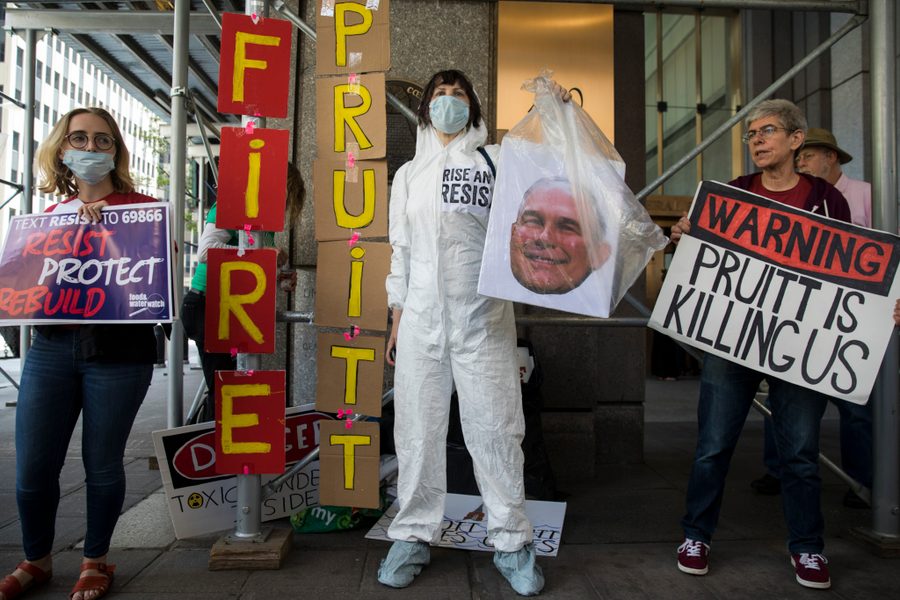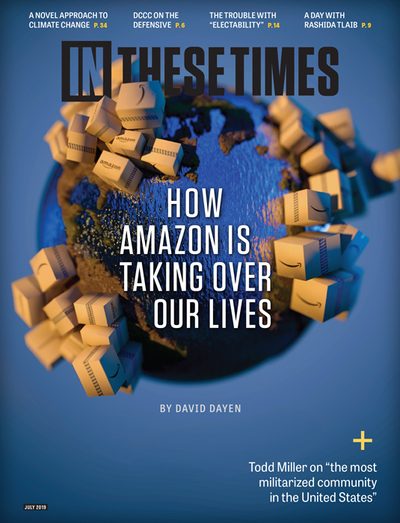Trump’s EPA Has a Monsanto Problem
The EPA is meant to protect us. Instead, it’s been captured by industry.
Joel Bleifuss

A jury awarded a California couple more than $2 billion in May for damages in their suit against Monsanto, a subsidiary of the chemical giant Bayer.
Farmers Alva and Alberta Pilliod claimed their use of Monsanto’s best-selling herbicide, Roundup, caused non-Hodgkin’s lymphoma in each of them, and presented internal Monsanto documents revealing the company covered up evidence that the herbicide itself, glyphosate, caused cancer.
That verdict marks the third consecutive decision against Monsanto; an additional 13,400 lawsuits are pending. Since acquiring Monsanto in June 2018, Bayer has lost more than 40% of its stock market value, now worth less in total than the original Monsanto price tag.
The EPA, whose officials have for decades proclaimed the safety of glyphosate over the objections of its own scientists, has come to Bayer’s defense, declaring April 30 that “glyphosate is not a carcinogen” and (when used properly) poses “no risks to public health.” Yet, in March 2015, the International Agency for Research on Cancer, citing multiple peer-reviewed studies, determined that glyphosate is “probably carcinogenic to humans.” One pivotal laboratory study using mice sounded the alarm as early as 1983. This February, researchers at the University of Washington found exposure to glyphosate increased the risk of certain cancers by more than 40%.
The fact that you can buy a carcinogenic herbicide at your local Home Depot is a prime example of “regulatory capture”: when an industry and its allies control the operations of a government agency to advance their own corporate interests.
Regulatory capture occurred, for example, when Scott Pruitt, Trump’s former EPA administrator, dismissed members of the EPA’s Science Advisory Board and Board of Scientific Counselors and replaced them with industry allies.
An industry-friendly EPA ensures there will be no new environmental regulations with teeth. Liam Condon, president of Bayer’s crop science division, shrugged off the $2 billion judgment, telling agricultural investors: “The key point is, from a regulatory point of view, nothing has changed.” Indeed, as Bayer appeals these cases, it will argue that the EPA determination that glyphosate is a noncarcinogen should preempt the right of state courts to rule against glyphosate manufacturers.
The legal doctrine of preemption holds that claims in state courts are not allowed if they conflict with federal law. Bayer’s hope is that the glyphosate cases end up in the Supreme Court, which has heard three analogous preemption cases since 2005 and, every time, ruled for the corporation.
It doesn’t hurt Bayer’s chances that Associate Justice Neil Gorsuch — who, as a federal judge, refused to let environmental groups participate in lawsuits involving public lands — would help decide the case. Neil’s mom, the late Anne Gorsuch Burford, an anti-environmental activist and President Ronald Reagan’s first EPA administrator, sits alongside Pruitt in the pantheon of corrupt GOP officials forced from office in disgrace.
Political radicals have long claimed that big business dictates government operations. Nevertheless, in the 20th century, pressure from the labor and environmental movements led to important regulations.
Today, we observe a Great Regression to the savage capitalism of the Gilded Age — the “deconstruction of the administrative state,” as Steve Bannon would call it. As the Democratic primaries approach, voters should distinguish candidates who have demonstrated an appetite to confront corporate power from those who have proven themselves beholden to it. It’s time to break the chains of corporate capture.

I hope you found this article important. Before you leave, I want to ask you to consider supporting our work with a donation. In These Times needs readers like you to help sustain our mission. We don’t depend on—or want—corporate advertising or deep-pocketed billionaires to fund our journalism. We’re supported by you, the reader, so we can focus on covering the issues that matter most to the progressive movement without fear or compromise.
Our work isn’t hidden behind a paywall because of people like you who support our journalism. We want to keep it that way. If you value the work we do and the movements we cover, please consider donating to In These Times.
Joel Bleifuss, a former director of the Peace Studies Program at the University of Missouri-Columbia, is the editor & publisher of In These Times, where he has worked since October 1986.








